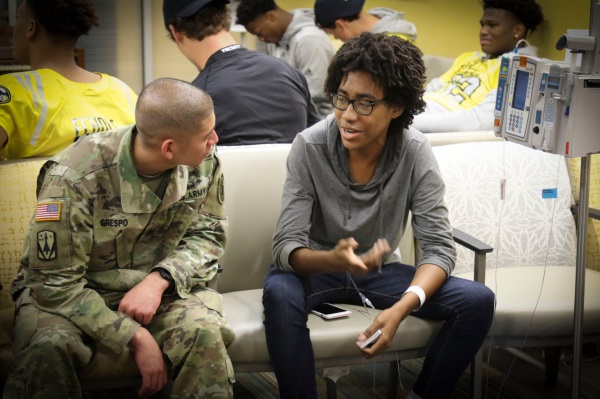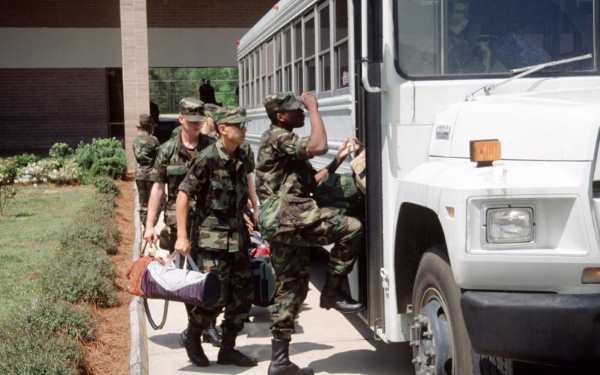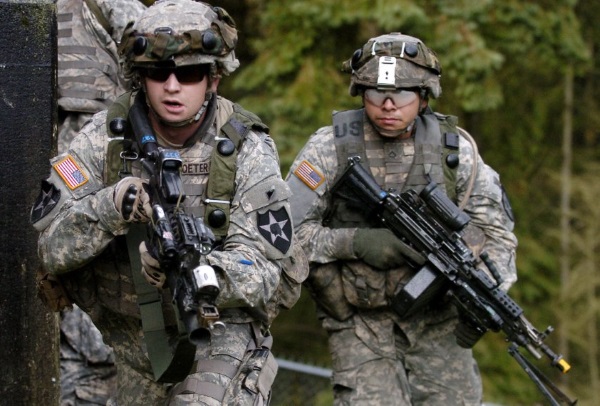So, you’re thinking about joining the Army…
Armed service within the United States Army is a highlight in just about everyone’s life who decides to take on the huge commitment.
Anyone who has gone through the recruitment process will agree that going through the enlistment process and becoming a regular Army soldier is not easy, yet completely worth it.
This article will discuss the steps that are required to accomplish becoming a new recruit.
How To Sign Up For The US Army
Visit A Recruiting Office
The first thing to do is locate your local recruiting station.
Recruiters cover territories that encompass the surrounding communities.

Depending on your home of record, which is your current address, there will be a specific recruiting station assigned to you.
You can find a recruiter near you via this link, or by a simple search.
Once you have been able to establish a meeting with a recruiter, he/she will begin to discuss your interests in joining the Army, what the Army can offer you for joining, and begin a preliminary diagnostic of your recruitment eligibility.
There are a number of questions you’ll want to ask them (or any military recruiter for that matter), including things like:
What happens after boot camp?
I want to be a (insert future job here). What MOS should I choose?
Where will I be based?
These questions, and more, are crucial to helping you determine whether or not the Army is right for you.
Depending on the needs of the Army at varying times, different MOSs offer enlistment bonuses for recruits that decide to commit to said MOS for their time in service.
These bonuses change on a monthly basis so be aware that if you find a good bonus deal to act quickly because the bonus may be pulled in the coming months.
See a full list of Army MOS’ and the required ASVAB scores here.
Furthermore, despite the notion that Army recruiters get a commission to get you to sign up, it’s a complete and utter myth.
Requirements To Join The Army
Education Level
A high school diploma or G.E.D. are required for military service.
If you have a college degree and hold the necessary amount of college credits you may be eligible to start your enlistment at a higher rank above Private, and may even be eligible for a commission.
Related Article – Joining The Military After College: How To Do It The “Right” Way
Criminal History
A criminal record of violent crimes will disqualify you for military service.
Felony convictions, or even a DUI, can present some problems as well.
Previous offenses such as violations or minor misdemeanors may be waived if all other requirements are met.
An Army recruiter will be able to answer any and all questions on that.
Age
The youngest age that is eligible for enlistment in the US Army is 17-years old.
If you are enlisting at 17 and are not already emancipated, then permission is required from a parent or legal guardian and will need to be a part of the enlistment process.
If you are over the age of 40-years old your are ineligible for military service. It is possible to have your age waived if all other requirements are met.
Marital / Dependency Status
If you are married and or have children and other individuals that qualify as a dependent, then their information will be included in your enlistment.
Your family and/or spouse is entitled to several benefits if you are enlisted and will be considered in the care of the Defense Department during your time in service.
Physical Condition
It is not expected that you will be able to meet the Army physical standards of fitness at the time of enlistment; that’s what Basic Combat Training is for.
However, it is important that your health is in good standing, and you are free of any conditions that could potentially disqualify you of military service.
Those include conditions like asthma, ADD / ADHD, autism, diabetes, flat feet, and a host of other medical conditions.
Once you have been screened by the recruiter you will then take a shorter version of the ASVAB (Armed Service Vocational Aptitude Battery).
The ASVAB is akin to the military’s version of the SAT/ACT tests. The test covers a broad spectrum of topics.
You will be tested for literacy, writing, mathematics, science, engineering, electrical and automotive skills, and other topics such as assembling objects and arithmetic.
Every occupation in the Army has skill sets as prerequisites, the higher your ASVAB score is the more jobs you will qualify for in the Army.
There is an interview process when joining the Army.
It may seem odd to conduct an interview with an Army recruiter but that is exactly what is expected of you.
This will be much like a civilian job interview.
They will request a resume and discuss previous employers, character references, criminal history, education levels, and individual character.
There is a lot of paperwork involved in the initial enlistment process.
We recommend you get used to this as the Army is the epitome of bureaucracy and you will spend the rest of your Army career dealing with paperwork and documents.
Documents required are:
- Social Security Card
- Proof of Citizenship
- Valid Driver’s license or other form of State ID.
- Marriage and/or divorce certificates, if applicable.
- Copy of lease or rent agreement, if applicable.
- High school diploma, GED certificate, college diploma.
Be advised that a thorough background check will be conducted via the Federal Bureau of Investigation.
Related Article – How to Join the US Military as a Non-Citizen
It is imperative that you disclose all previous encounters with government and law enforcement as any encounter will be discovered during the background check and interviews of friends, family, and administrators.
The Military Entrance Processing Station (MEPS) Process
Once you have been thoroughly screened and have decided your potential future MOS (Military Occupational Specialty) your recruiter will send you to the nearest MEPS, the Military Entrance Processing Station.
At MEPS you will undergo several tests to confirm you are physically qualified for armed service.
You conduct eye-exams, color blindness tests, hearing tests, and go through additional interviews.
You will have a complete head-to-toe physical to determine your health and conduct two physical fitness tests.
The first test will exam your ability to move and your range of motion by stretching and moving your body in various ways, such as the duck walk, low crouch, prone crawl, and exercises like the supine bicycle, the push-up, the jumping-jack, and others.
Next you will be subjected to an APFT or Army Physical Fitness Test.
This test is the standard Army fitness test that you will conduct throughout your career.
If you pass this test and meet the Army standards then you will qualify for more MOSs and be in good standing as you are sent to BCT, or Basic Combat Training.
If you fail this test, you are not disqualified from service in the Army, it will however limit possible MOSs.
The MEPS process is very thorough and will take approximately two days to complete.
Once you have been cleared by the MEPs command staff you will swear-in to your first oath of loyalty to the United States Army.
Upon completion of MEPs you are officially a United States Army recruit.
Your next step will be to maintain contact with your recruiter and Recruitment Battalion that you will be assigned to.
You will also receive your ship-out date for Basic Combat Training, and the location of where you will conduct said training.
The Army has four locations that train new recruits:
- Fort Benning, Georgia
- Fort Leonard Wood, Missouri
- Fort Jackson, South Carolina
- Fort Sill, Oklahoma
You are typically assigned to these forts based on your MOS.
For example Field Artillery, Air Defense Artillery, Armor, and the many support jobs integrated into these sections are sent to Fort Sill for training.
Related Article – List of Army Bases in the US
Basic Combat Training

BCT, or Basic Combat Training, is where you will learn the basic skills of soldiering in the United States Army.
Upon arrival to your Fort where you will conduct BCT training you will be assigned to what is called the reception battalion.
Related Article: How Hard Is Army Basic Training?
Reception Battalion is where you will be briefed on the training that lies ahead of you. You will be issued your uniforms and gear.
You will undergo further medical exams and be given several vaccinations and given the infamous recruit shaved head haircut.
The drill sergeants will facilitate drill and ceremony training as well as review uniform standards, rank structure, barracks upkeep standards, and plenty of basic Army skills.
After the week of reception you will be sent to your training company and begin BCT.
Drill sergeants will be with you 24/7 for the entire 12 weeks of training.
They will be brutally hard on you both physically and mentally and you will be challenged.
At the end of the training however you will be grateful for their tough love and experience.
Every soldier remembers their drill sergeant and once you have officially become a soldier they will treat you as any other private in the Army.
Basic Training is separated into three phases, Red Phase – White Phase – Blue Phase.
Red Phase concentrates on drill and ceremony, physical fitness, obstacle courses, core Army values, traditions and ethics all the while recruits are under total control of the drill sergeants.
This phase is very physically demanding and intended to build camaraderie, individual fitness, and what it means to be a soldier.
White Phase is almost entirely spent on weapons training, land navigation, and combat skills.
You will spend weeks on the firing range training to use the M-4 carbine which is the predominant primary firearm for Army soldiers.
You will also training using M67 fragmentation grenades by throwing live grenades at area targets and dummy grenades during training lanes where recruits move to an object while deploying dummy grenades at targets.
Crewserve weapons are also part of the training. You will fire the M249 Squad Automatic Weapon, or SAW, the M249B machine gun, the M2 anti-aircraft gun, the AT4, or Anti-Tank 4, rocket launcher on armored targets, the M203 and M320 handheld grenade launchers, the MK48 mounted grenade launcher, and several other weapon systems.
All of these weapons are a part of the standard armament of an infantry platoon.
Related Article – Navy SEAL Weapons and Gear: 24 Rifles, Handguns, Shotguns, and More
Blue Phase is where all your previous training comes together. You will conduct FTXs, or Field Training Exercises.
Here you will move as a unit with your armaments to an objective while engaging hostile forces, typically other recruits posing as OPFOR, or Opposing Force.
You will conduct land navigation lanes where you must navigate terrain and find points given to you, in grid coordinates.
You will also cover Forward Operating Base operations, Entry Control Point security, POW survival training, and many more tactical operations.
Upon graduation you will officially be a soldier in the Army and will embark on your advanced individual training and learn the ins and outs of your MOS.
Conclusion
These steps have provided you with the recruitment process.
From the day you think about joining the Army, to the day you become a United States Army soldier, just about every step of the way has been covered by this article.
For more information check out the Army’s recruitment website at www.GoArmy.com.
Be sure to stop by your local recruiting station and talk with the Sergeants and review their reading material.
- 68 Series MOS: A List of Medical Field Jobs in the Army - June 19, 2024
- 15 Series MOS: US Army Aviation Jobs - June 19, 2024
- 11 General Orders For Each Military Branch - June 19, 2024

